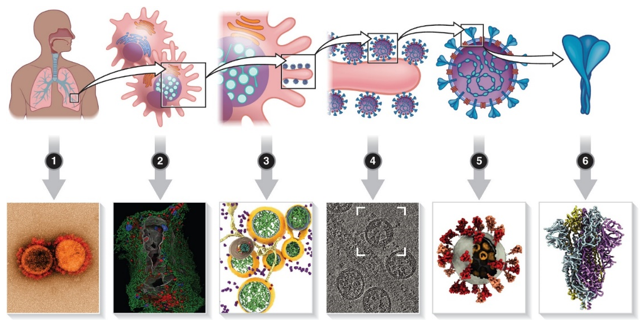Infectious Disease Research Using the iEM Platform
Electron microscopy (EM) plays a pivotal role in identifying the causative agents of infectious diseases in early studies. It is an important technique for diagnosing pathogens and identifying microorganisms in tests. At the iEM Platform, advanced EM methods and atomic force microscopy (AFM) are used to characterize various pathogens and their ultrastructure, contributing to a better understanding of the development and treatment of infectious diseases.
 Fig1. Electron microscopy in COVID-19 research. (Cortese, M., & Laketa, V, 2021)
Fig1. Electron microscopy in COVID-19 research. (Cortese, M., & Laketa, V, 2021)
Services Offering

The increasing world population, rising global travel, and global climate change have increased the coverage, speed, and efficiency of infectious diseases, leading to an increased threat of pandemics. Creative Biostructure is at the forefront of the convergence of physical and life sciences. We have launched an integrated EM platform, which provides all levels of technical support and consultation for our customers who need analysis, EM imaging, and AFM imaging. Based on specialized equipment and experienced technical staff, we can effectively and reliably advance multiple infectious diseases research, including bacterial diseases and viral diseases.
- Bacterial diseases
Bacteria can build symbiotic or pathogenic relationships with their hosts, which have attracted extensive attention from researchers. By means of EM and AFM, we can perform morphological study, ultrastructural characterization, and biofilm formation analysis of bacteria. Our services can be applied to study the interactions between bacteria and their target tissues/cells in vivo and in vitro. In vitro tests, such as cell culture tests, the relationship between the ultrastructure of bacteria and its culture and molecular characteristics can be further studied. Our services can support,
-Characterization of new bacterial species.
-Investigation of the morphology of bacteria in various conditions.
-Study on the interaction between bacteria and host cells in cell culture and tissue samples.
- Viral diseases
EM has long been the preferred method for the direct visualisation of viruses. EM can promote viral diagnoses, as well as in the study of virus structure and pathogenesis. For virus detection and identification, we employ imaging techniques with nanometer-scale resolution, including electron microscopy (TEM), scanning electron microscopy (SEM), and cryo-electron microscopy (cryo-EM). Sample preparation includes negative staining, ultrathin sectioning, cryo-ultramicrotomym, and so on. In addition, we also offer cryo-EM analysis for a better understanding of the aspects of viral infection. Our experts have years of experience in studying different aspects of virus infection and pathogenesis by using cryo-EM. We are able to assist researchers in all aspects of the cryo-EM workflow, ranging from cryogenic sample preparation, grid screening, high-resolution data collection, to preliminary data analysis. Our services can support,
-Virus detection and identification.
-Characterization of new viral species.
-Analysis of viral mechanisms of replication and pathogenesis.
-Structural analysis of virus in the vaccine and anti-viral drug development.
- Emerging infectious diseases
In recent years, emerging infectious diseases (EID) and their associated public health emergencies (such as Ebola, Zika virus, coronavirus and pandemic influenza) have been increasing. At the iEM Platform, we can also assist researchers in investigating these pathogens.
Talk to our experts to get more information. contact us right now! We"d be happy to discuss any projects and see how we can support your work.
- Golding, C. G., et al. (2016). "The scanning electron microscope in microbiology and diagnosis of infectious disease." Scientific reports, 6(1), 1-8.
- Cortese, M., & Laketa, V. (2021). "Advanced microscopy technologies enable rapid response to SARS‐CoV‐2 pandemic." Cellular Microbiology.

